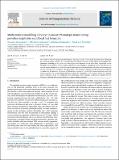Files in this item
Mathematical modelling of cancer invasion : phenotypic transitioning provides insight into multifocal foci formation
Item metadata
| dc.contributor.author | Szymańska, Zuzanna | |
| dc.contributor.author | Lachowicz, Mirosław | |
| dc.contributor.author | Sfakianakis, Nikolaos | |
| dc.contributor.author | Chaplain, Mark A. J. | |
| dc.date.accessioned | 2023-11-30T11:30:01Z | |
| dc.date.available | 2023-11-30T11:30:01Z | |
| dc.date.issued | 2024-01-01 | |
| dc.identifier | 295709542 | |
| dc.identifier | b79daf14-a65d-4580-a7f1-dabb0355458e | |
| dc.identifier | 85178324897 | |
| dc.identifier.citation | Szymańska , Z , Lachowicz , M , Sfakianakis , N & Chaplain , M A J 2024 , ' Mathematical modelling of cancer invasion : phenotypic transitioning provides insight into multifocal foci formation ' , Journal of Computational and Applied Mathematics , vol. 75 , 102175 . https://doi.org/10.1016/j.jocs.2023.102175 | en |
| dc.identifier.issn | 0377-0427 | |
| dc.identifier.other | BibCode: 2023arXiv230514388S | |
| dc.identifier.other | ORCID: /0000-0001-5727-2160/work/147966924 | |
| dc.identifier.other | ORCID: /0000-0002-2675-6338/work/147967399 | |
| dc.identifier.uri | https://hdl.handle.net/10023/28796 | |
| dc.description | Funding: Z. Szymańska acknowledge the support from the National Science Centre, Poland – grant No. 2017/26/M/ST1/00783. N. Sfakianaki’s scientific visit to the University of Warsaw was partially supported by the Excellence Initiative Research University Programme at the University of Warsaw. M. Lachowicz is happy to acknowledge the support from the New Ideas Grant - ”Równania kinetyczne w opisie zjawisk samoorganizacji” funded by the Excellence Initiative Research University Programme at the University of Warsaw. | en |
| dc.description.abstract | The transition from the epithelial to mesenchymal phenotype and its reverse (from mesenchymal to epithelial) are crucial processes necessary for the progression and spread of cancer. In this paper, we investigate how phenotypic switching at the cancer cell level impacts on behaviour at the tissue level, specifically on the emergence of isolated foci of the invading solid tumour mass leading to a multifocal tumour. To this end, we propose a new mathematical model of cancer invasion that includes the influence of cancer cell phenotype on the rate of invasion and metastasis. The implications of model are explored through numerical simulations revealing that the plasticity of tumour cell phenotypes appears to be crucial for disease progression and local invasive spread. The computational simulations show the progression of the invasive spread of a primary cancer reminiscent of in vivo multifocal breast carcinomas, where multiple, synchronous, ipsilateral neoplastic foci are frequently observed and are associated with a poorer patient prognosis. | |
| dc.format.extent | 15 | |
| dc.format.extent | 3953593 | |
| dc.language.iso | eng | |
| dc.relation.ispartof | Journal of Computational and Applied Mathematics | en |
| dc.subject | Cancer invasion | en |
| dc.subject | Phenotypic switching | en |
| dc.subject | Epithelial-mesenchymal transition | en |
| dc.subject | Invasive foci | en |
| dc.subject | Multifocal cancer | en |
| dc.subject | RC0254 Neoplasms. Tumors. Oncology (including Cancer) | en |
| dc.subject | T-DAS | en |
| dc.subject | SDG 3 - Good Health and Well-being | en |
| dc.subject | MCC | en |
| dc.subject.lcc | RC0254 | en |
| dc.title | Mathematical modelling of cancer invasion : phenotypic transitioning provides insight into multifocal foci formation | en |
| dc.type | Journal article | en |
| dc.contributor.institution | University of St Andrews. Applied Mathematics | en |
| dc.identifier.doi | https://doi.org/10.1016/j.jocs.2023.102175 | |
| dc.description.status | Peer reviewed | en |
| dc.identifier.url | https://arxiv.org/abs/2305.14388 | en |
| dc.identifier.url | http://adsabs.harvard.edu/abs/2023arXiv230514388S | en |
This item appears in the following Collection(s)
Items in the St Andrews Research Repository are protected by copyright, with all rights reserved, unless otherwise indicated.

